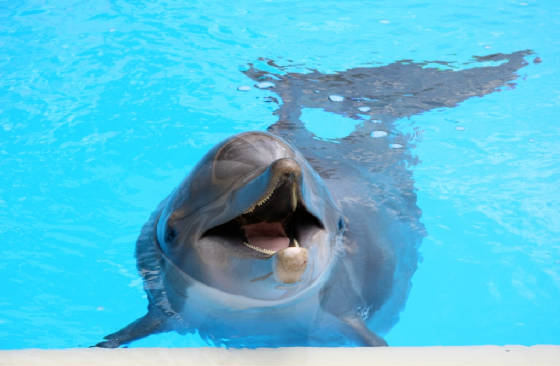|
INTRODUCING...THE ATLANTIC BOTTLENOSE DOLPHIN

The Earth's oceans support approximately 33 species of salt water
dolphins, one of which is the Atlantic Bottlenose Dolphin, Tursiops truncatus. The term "bottlenose" is actually
a misnomer. The nose (or "blowhole") of the dolphin is no where near the bottle-shaped rostrum, or beak. The word "dolphin"
is derived from the Ancient Greek, meaning "fish with a womb". The Atlantic Bottlenose Dolphin was first described by Montagu
in 1821. It lives in temperate and tropical waters, absent only from 45 degrees latitude to the poles in both the northern
hemisphere and the southern hemisphere. It inhabits coastal areas, bays, estuaries and river mouths as well as living offshore
along the oceans' continental shelves. Its charming underbite and large eyes make it a favorite of all who come upon
it in the wild or view it in captivity. It is a mammal and should not be confused with the dolphin fish
known as mahi mahi. Additionally, it should not be confused with a porpoise, also a mammal, but quite different in appearance.This
site is dedicated to the understanding and conservation of this beautiful animal and to the presentation of information
and current research on the both the Atlantic Bottlenose Dolphin, and dolphins in general, in a reader-friendly
style. Whenever possible, videos and photographs are presented
to enhance topics being discussed.
JUST USE THE MENU ALONG THE LEFT SIDE
OF THIS SITE TO ENJOY ITS MANY FEATURES.
THANKS FOR VISITING
UNDERSTANDDOLPHINS.COM
Site Content
Understanddolphins.com contains information condensed from a number of reputable technical sources,
peer reviewed journal articles, and respected dolphin research facilities, as well as from my personal experiences and
observations as a dolphin VIP Tour Guide and Educator.
I have made every attempt to support the information presented in this site with video and still
photographic images. On a regular basis I plan to produce more of these images and will continue to update the site with these
as well as with any new and scientifically verified information which becomes available.
|




